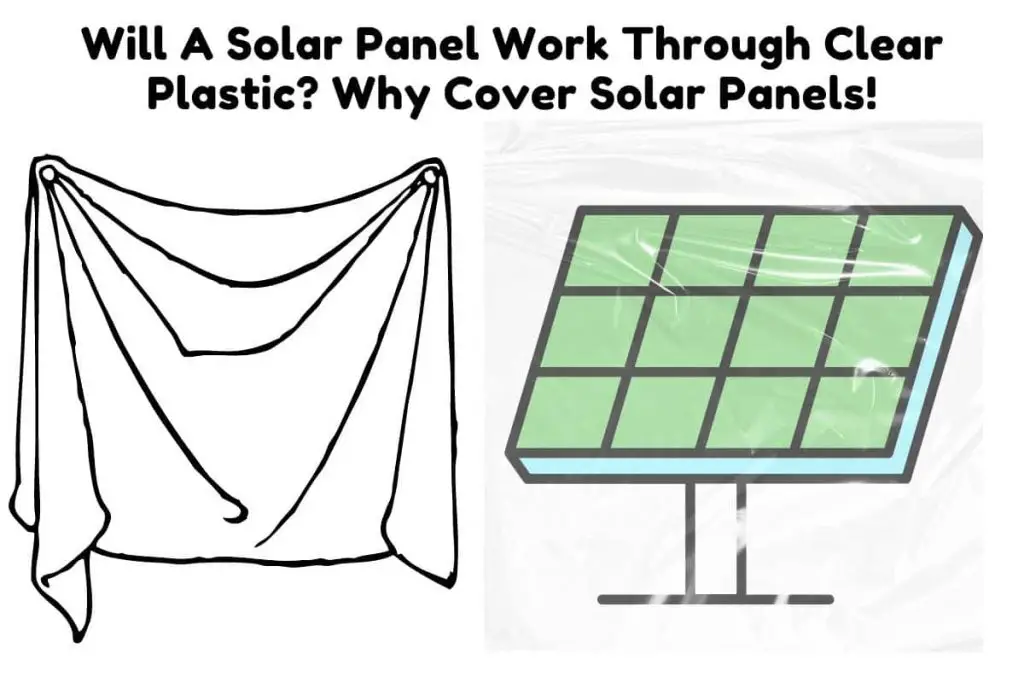A solar panel produces electricity when it is exposed to sunlight. The light does not necessarily have to be direct or even from the sun. Solar panels still generate electricity in shade, through clear or colored plastic, and even underwater. While it may still work under those conditions, its performance will suffer.
In this article, we explore how some of those conditions affect solar panel performance. Specifically, we will look at how plastic can be used with solar panels. We will also compare glass and plastic covers on solar panels.
Finally, we will round off by looking at what you should do with your solar panels when they are not in use. Do you need to cover them up or disconnect them?

Can A Solar Panel Be Used Through Plastic?
A solar panel will still work even through a transparent material like plastic as long as it allows light to pass through. It will, however, produce slightly less electricity. Placing plastic between the light source and the solar panel has the effect of reducing the amount of light reaching the solar cell. Essentially, the less light the solar panel receives, the less electricity it produces.
On a side note! If you’re in need of a reliable and high-performance portable solar panel, We strongly recommend the Jackery SolarSaga 100W Portable Solar Panel (Amazon Link).
With a high conversion efficiency and foldable design, this solar panel is easy to transport and set up, making it perfect for outdoor activities like camping, hiking, and RV trips.

The US solar cell technology used in this panel ensures that you get the most efficient and reliable solar charging possible.
There is also a 60W option that is more affordable (Amazon Link)
Solar panels generate electricity from sunlight. They can also be used with artificial light sources like fluorescent or incandescent light bulbs. Sunlight, is, however, much more energy dense than any manmade light.
Introducing a layer of plastic between the solar panel and sunlight has two effects. It decreases the incidence of light on the solar panel and creates an air gap.
Reduced light absorption
Plastic absorbs light. How much light a plastic absorbs depends on the type of plastic, the thickness of the plastic, and the wavelength of light.
Different types of plastic absorb different wavelengths of light. Generally, most plastics will absorb or reflect light that is below 300nm. What this means is some of the light that would have reached the solar panel in the absence of the plastic does not reach the panel.
The thickness of the plastic will also affect how much light it lets through. Naturally, a thin layer of plastic will let through more light than a thicker layer.
Air gap
The air gap between the plastic and the solar panel will also affect how much light is let through. It will also result in condensation and excess humidity due to the heat collected in the air gap.
Coating or laminating a solar panel with plastic is one way in which some solar owners choose to protect their solar panels from damage. While it can be beneficial, it does have some drawbacks especially if the wrong type of plastic is used. Source
Can Polycarbonate Be Used For Solar Panels?
Polycarbonate is one of several plastics used to manufacture solar panels. It’s especially suited for solar panels because it is both lighter and stronger than glass. This results in a solar panel that is lighter but without compromising the protection of the solar cells.
Up to 90% of the weight of a solar panel is in the glass cover. A polycarbonate plastic cover drastically reduces the weight of the solar panel which makes for easier handling and installation. At the same time, polycarbonate has 200 times the impact resistance of glass.
The major downside to plastic is that it degrades quickly. The cover may become cloudy or filmy, reducing the amount of light reaching the solar cells. It’s also much more likely to warp and change shape due to the extreme temperature a solar panel experiences. This introduces the risk of water seeping into the panel.
There are several other types of plastic covers used for solar panels. The most commonly used are acrylic, plexiglass, and glass-reinforced polyester. Source
While plastic may be lighter and allows for a more flexible solar panel, glass holds up better over time since it does not degrade like plastic. But what would happen if you removed the covers altogether?
Can A Solar Panel Work Without Glass On It?
The primary component of a solar panel is the solar cells that produce electricity. The glass is there to protect the solar cells. Removing the glass cover would expose the cells to damage although the solar panel would still generate electricity.
The glass cover protects the solar cells from impact damage and moisture. The glass on a solar panel is tempered glass six times stronger than ordinary glass. This is necessary to prevent the solar cells from getting damaged by a falling tree branch or stray golf ball for example.
The glass and frame of the solar panel also create a waterproof encapsulant for the solar cells. Exposing the solar cells to moisture would short circuit them. In short, the glass on a solar panel is there to allow light through while keeping everything that could damage the solar cells out.
Also check out What Is The Short Circuit Current Of A Solar Panel? What Happens!
Should I Remove The Plastic From A Solar Panel?
Solar panels are shipped and transported with a thin film of plastic over them. This layer of plastic is there to protect the solar panels while it is in transit. It is meant to be removed before the solar panel is put to use.
It is a temporary protective wrapping almost like how bubble wrap and Styrofoam protect electronics while they are in transit. It will only reduce the efficiency of the solar panels and is not worth keeping on. It also starts to get cloudy as it gets older, further reducing the efficiency of the solar panels. Source
Can You Cover Solar Panels With A Tarp?
While it is not strictly necessary, solar panels can be covered when they are not in use. A tarp is one of several coverings that can be used to prevent light from reaching the solar panels. Almost any dark, opaque material can be used.
There are several reasons why you might want to cover them. It could be for a long vacation and the house might be vacant while you’re away. It also could be to protect them against heavy storm damage
Generally, there is rarely any pressing need to cover the solar panels. They are built to withstand extreme weather and solar panels are largely self-regulatory when combined with charge controllers and inverters.
